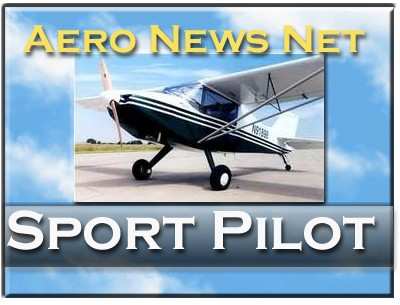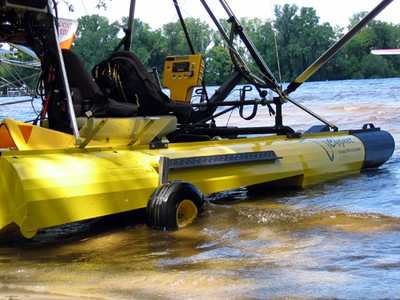Bright Minds Have Repositional Limits
By ANN Contributor John Ballantyne
Sport Pilots may fly Light Sport Aircraft, says FAA. And Light
Sport Aircraft are limited, in part, to "repositional landing
gear." What in the world does this new phrase "repositional landing
gear" mean?

According to FAA, repositional landing gear is wheeled landing
gear that allows an aircraft, designed for operation on water, to
take off and land from a hard surface as well. The wheels cannot be
retracted. Instead, "repositional" landing gear must remain fixed
in its position from takeoff through landing.
So, a Sport Pilot may fly a plane where the gear can go up and
down, but only on the ramp or alongside the dock. There is one
exception that we'll get to in a minute. But first, why did the FAA
enact this odd rule for Sport Pilots?
Short answer: to avoid adding mechanical or operational
complexity in a Sport Pilot's aircraft. Perhaps we can assume that
FAA wasn't worried much about a Sport Pilot who would taxi for
takeoff without noticing that full power was required to drag the
hull, wheels-up, scraping along the asphalt taxiway. Probably
regulators are more concerned about someone landing in the water
with wheels down -- or on the ground with the wheels up.
In other words, Sport Pilots aren't expected to cope with a
landing check list containing "U" for Undercarriage. The FAA
apparently does expect a Sport Pilot to manage landing check lists
including fuel tank selection, various flap settings, perhaps
spoilers, fuel mixture, power and airspeed management, other air
traffic, radio tuning and communication, monitoring of engine gages
and more.
I guess we should be thankful that there's no "U" to complicate
matters. Besides, any pilot of complex retractable airplanes knows
that it is not if you will land on land with no wheels, it is when
you will land with that skidding sound.
The situation regarding skis is much the same. FAA believes that
skis are acceptable for light-sport aircraft flown by Sport Pilots,
but a retractable combination of wheels and skis is not
allowed.
There is, however, one big, fat exception. The FAA thinks that
Sport Pilots will have the mental faculties to handle the wheels
up/down issues only if they are piloting gliders. That's right.
Light Sport Aircraft gliders may have retractable land gear. This
is where you may roll down the runway (perhaps under your own
power!), take off, retract the wheel(s), fly, then put the wheel(s)
back down and land; or just leave the rollers up for
splash-and-dash operations; or mix and match. Complicated, right?
Apparently, that's why it is only permitted for glider pilots.
Perhaps the FAA thinks that having no engine will permit the
Sport Pilot the mental capacity to deal with wheels up or down.
Hopefully the glider pilot will not become overloaded with
altitude/airspeed management, spoiler and/or flap settings, other
landing pattern traffic, radio tuning and communication. Don't
forget the notion of having only one opportunity to land on the
runway. Don't you agree that this simplified checklist will allow
for the acuity to handle the additional mental load of deciding
"Gear up, Gear down"?

The FAA allows Sport Pilots to fly "Powered Gliders." Because
Powered Gliders (Light Sport Aircraft) may have wheels that go up
and down in flight, this offers a work-around for Sport Pilots who
crave retracts. Be aware: you will now have the combined checklist
of the glider and powered aircraft. Mental overload may be
inevitable (if FAA's original rational was correct)!
Incidentally, powered gliders flown by Sport Pilots also may
have autofeathering propellers. All other Light Sport Aircraft must
have fixed-propellers (ground adjustable is okay).
In all fairness, the FAA says it will reconsider this matter in
Advisory Circulars that are scheduled to come soon. Let's give the
FAA a big hand for making such an inventive attempt to manage the
level of complexity for Sport Pilots. This particular method,
however, seems too ambiguous to float.
 NTSB Prelim: Cirrus Design Corp SR20
NTSB Prelim: Cirrus Design Corp SR20 ANN's Daily Aero-Linx (11.30.25)
ANN's Daily Aero-Linx (11.30.25) ANN's Daily Aero-Term (11.30.25): Wind Shear Escape
ANN's Daily Aero-Term (11.30.25): Wind Shear Escape Aero-News: Quote of the Day (11.30.25)
Aero-News: Quote of the Day (11.30.25) Airborne 11.26.25: Bonanza-Baron Fini, Archer v LA NIMBYs, Gogo Loses$$$
Airborne 11.26.25: Bonanza-Baron Fini, Archer v LA NIMBYs, Gogo Loses$$$




